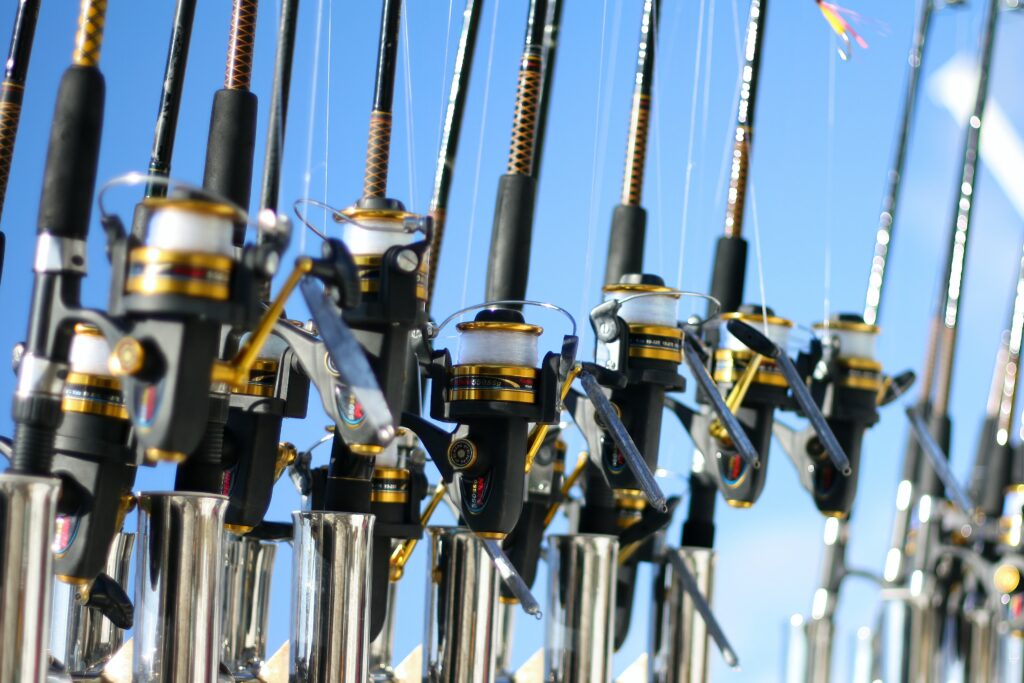Last week I discussed how to select the proper fishing rod, this week I will tell you how to select the right reel for the task at hand. There are four basic types of reels: spin-cast reels, spinning reels, bait-casting reels, and fly reels.
Spin-Cast Reels utilize a simple design, they are easy to use, and reasonably priced, thus making them ideal for beginners and children. The line spool is encased in a protective case (shell) that has a single opening in the front to allow the line to leave the reel. These reels have a button on the back of the that allows you to lock the line, or disengage to let the line move freely when casting.
Spin-cast reels also have a drag adjustment located somewhere on the shell which controls how much resistance the line offers when a fish is pulling on the line
The line spool and associated drive mechanism is located within the case which means if the line gets tangled, it is somewhat problematic to deal with. Another problem is debris stuck to the line may be trapped inside when you reel in. This is why it is a good idea to hold your thumb and forefinger as you reel in to wipe off any debris. Although you can buy a Spin-cast reel for under $10, don’t expect much service out of a cheap spin-cast reel.
The advantages of a spin-cast reel are: inexpensive, easier to use
No backlash ( a condition in which the line clumps together due to the spool moving too quickly, you can use lightweight line and lures, easier to cast near the shore and under trees, easy to cast using right or left-handed by changing orientation, easy to add more line capacity with an additional reel, ideal for fishing from the shore.
The disadvantages are: the reel has more bulk, is not as durable, particularly the cheap ones, the line can become entangled inside the housing, less drag control, and little, if any distance control.
Spinning Reels are designed with an open face and a metal bail, which acts as a gate, to prevent the line from nesting. The reel is mounted on the bottom of the rod, as opposed to on the top of the rod as is the case with spin-cast rods. This provides improved balance when casting and the drag adjustment is found on the top of the reel.
There are five major components of a spinning reel: the drag adjustment, the spool, the bail, the handle, and the anti-reverse switch.
A spinning reel provides more control than a spin-cast reel. To unlock the line to cast, you merely disengage the metal bail and firmly hold the line with your index finger to prevent tangling and spooling before you cast.
When you are ready to cast, just release your index finger and let go of the line, once you are at the top of the cast. To prevent the line from unspooling, move the bail back to the starting position by turning the crank once you have finished the cast. More expensive spinning reels have an anti-reverse switch that locks at the line.
The advantages are: they are typically better constructed, provide more control of speed and distance when casting, have better drag control, great to place in a rod holder and let it stay there while you wait for a fish to bite. Bottom mounting gives better balances, better drag control, the crank arm can be moved to the left or right side, and is ideal for multiple fish habitats.
The disadvantages are: Doesn’t work as well or cast as far using heavier lures, although cheaper ones are comparably priced to spin-cast reels, the professional spinning reels can exceed $1,000, they are not designed to reel in really large fish, and you must carefully use the bail to parenting entanglement.
Bait-Casting Reels are mounted on top of the rod and the spool is perpendicular to the rod. They perform well with monofilament, fluorocarbon, and braid-type lines The line-spool on a bait-cast moves with the line, thus requiring more skill to maintain control.
As with spinning reels, the spool can move faster than the line is coming off the reel, causing the line to bunch up. Although This type of reel is more advanced and is better suited to a seasoned angler, you can use many types of lures, and bait, making it quite versatile.
Advantages are: they are durable, lightweight, low-profile, can accept more line and heavier line, have excellent drag capabilities, can be used for large, powerful fish, and is easily customized.
Disadvantages are: more expensive, requires more skill and is harder to learn to use, prone to backlashes, and it is harder to change left and right orientations.
Fly Reels are single-action reels typically operated by stripping the line using one hand while casting with the other hand. The fly reel was patented in 1874 by Orvis Charles in Vermont.
The main functions of the fly reels are essentially the same as they were when it was invented.
They are: storing the line, creating a smooth, continuous drag when trying to land a fish that puts up a fight, and counterbalancing the weight of the rod while casting.
Early fly reels often had no drag, you had to apply pressure with the palm of your hand to the rim of the moving spool.
Modern fly reels generally incorporate disc-type drag (braking) systems with enhanced adjustment range and are more resistant to the heat produced during braking.
Sealed drag systems keep debris out of the reel, but there are only certain materials that can be used for the construction.
Open drag systems are easily disassembled, can be easily rinsed to keep clean, and are usually less expensive.
Automatic Fly Reels utilize a coiled spring mechanism that retrieves the line by simply pushing a lever. with the click of a lever. Due to their increased weight and limited line capacity, they are not very popular.
Pros and Cons of Fly Fishing
Pros-You can cast a tiny, lightweight fly long distances. You are using the weight of the line instead of the weight of the lure to cast. You can achieve a quieter and more delicate presentation of the fly than you can with a lure. If you are a skilled fly angler, you can place the fly on top of the fish is without disturbing the fish, flies cost less than lures,
Cons- You need much more room to cast your bait, casting with a fly reel takes skill, patience, and practice to become proficient., it’s not suited for deep-fishing, you should use a spinning reel for that scenario,and although flies are cheaper than lures, the overall cost of line and gear is more than fishing with spinning reels.
Here are some criteria to consider when choosing a fishing reel: Spool material – aluminum vs. graphite, braided grip design on the spool, which means the spool will accept braided line which spools out more smoothly, more bearings for smoother retrieval, the material the handle is made from, how smoothly it rotates- no wobble while reeling in, the construction of the frame (or shell), the type of drag system, and the gear ratio (a higher gear ratio means you will be able to retrieve the line faster).
You now have a working knowledge of how to select all the components of a fishing rig.











